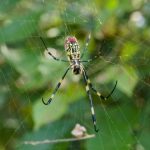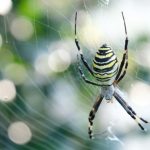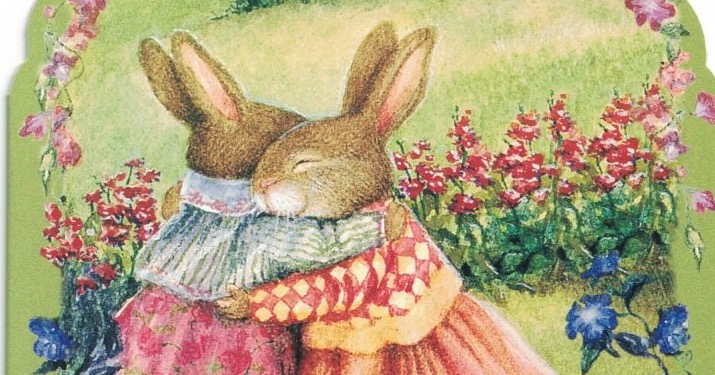和訳(ルビ完備!)は英文の下にございます。/ Japanese translation, fully rubbied, is below the English text.
JORO SPIDERS AND EDAMAME
Contents 1. News about Joro Spiders 2. Two Issues 3. “Joro Spiders” in Japan 4. A Japanese adage about spiders 5. How can we control Joro Spiders?
1. News about Joro Spiders

In a recent Wall Street Journal, we read an interesting article about the latest foreign spider in the southeast US. This fall, big spiders called Joro Spider (scientific name Trichonephila clavata) have been found in large numbers in some counties in northern Georgia.
They are relatively new in the region, and the people in Georgia are surprised at their size (females are larger than males and their bodies can be as big as 35 millimeters/1.5 inches), their colors (females have wide bands of blue and yellow in the belly), and the multilayered webs of strong, yellow threads they weave.
Some people see their yards covered by thick laces of their creepy webs, and are very annoyed. They try to burn them, stomp on the spiders, or spray insecticide at them.
Joro Spiders don’t have venom which is harmful to people. However, as an invasive species that lays hundreds of eggs, we don’t know what they will do to the ecosystem in North America.
2. Two Issues
This news about Joro Spiders attracted my attention in two regards.
One, we are living in South Carolina, just next to Georgia. According to the news, Joro Spiders are spreading into neighboring states, and already some were found in northern South Carolina. It’s very likely that next fall, they will appear in our yard, too. I don’t particularly like spiders, so I would rather they stay away.
Another thing about Joro Spiders is that Americans call them by their Japanese name. Its name in Japan is Joroo Gumo (pronounce “oo” as a prolonged “o”).
We now spell “joroo” “女郎”, which is an old word for prostitute, and is not a very good word. Some say it used to be spelled “上臈” (pronounced “jooroo” and sounds very similar), meaning a high-rank lady of the Imperial court. In either case, the spider was named after the female’s colorful body.
“Gumo” is a variation sound of “kumo”, meaning spider.
It seems that the spiders have begun to live in Georgia since 2013-2015, and that they were transported by ships from China and/or Japan.
3. Joro Spiders in Japan
Joro Spider (Trichonephila clavate) are often observed in Japan, except in Hokkaido, where the climate is too cold for them.
Also, they commonly live in other Asian countries such as China, Korea, Taiwan, India, among others.
Therefore, in my opinion, the English name for Trichonephila clavate doesn’t have to adopt the Japanese word “Joro”.
In addition, in many parts of Japan, “Joro Gumo” also means Argiope Spider (Argiope amonea), another, similar looking species. It means Joro Gumo is the name for two species, and it’s sometimes confusing even to the Japanese.

For example, an event called “National Joro Spider Sumo Wrestling Tournament” has been held annually in Shimanto City, Kochi Prefecture. Kids bring their own warrior spiders and have them fight on a thin wooden stick at a shrine. These spiders are Argione Spiders.
In olden days, spider sumo tournaments were popular, but today it’s a rare event. As for the origin of the tournament in Shimanto City, they say that ladies in the Imperial court (the Jooroos) evacuated Kyoto during the Onin War (1467-1477), came to this area, and began this game to alleviate their boredom during their country life.
4. A Japanese adage about spiders
There is an old adage in Japan: “Do not kill a spider in early morning (Asa no kumo wa korosuna).” This is not only about Joro Spiders, but about spiders in general.
This teaches us: If you see a spider in the morning, the day is likely to be fine weather, and the spider is usually busy making a web to catch insects. Spiders’ prey is often harmful or inconvenient for humans. As for the Joro Spiders, they eat flies, mosquitoes, gnats, wasps, stink bugs, among others.
Japanese websites explaining about Joro Spiders often mention this saying and remind people they do not necessarily have to kill them.
5. How could we control Joro Spiders?
However, I personally wouldn’t like to live among Joro’s thick webs. If I feel they become invasive, how can I control them?
Some say that removing the webs by wrapping them around a long stick would be enough to clean up around the house and the yard. Doing this will not discourage the spiders; they will return and make webs at the same location again. At one point, I may find a spray to deter them from making webs.
Others say that we can first try to eliminate or reduce their prey. Spiders make webs choosing a site where they know they catch more insects. For example, a pond with stagnant water may be a birthplace of mosquitoes, and therefore many spiders can choose that area. Or fluorescent lights on the house may attract moths and stink bugs, so replacing them with LED lights may eventually help reduce the spiders.
The ultimate “organic” way to dispose them is to catch and eat them. There are people who appreciate insect eating, and who say Joro spiders can be a good starter for beginners. It is a hearsay of a hearsay on Japanese websites, but particularly good are deep-fried, pregnant, plump females. Legs are just crunchy but the body tastes a little like edamame.
I will try the stick first.
[End of the English post]
ジョロウグモと枝豆
目次
1.ジョロウグモのニュース
2.二つの問題
3.日本のジョロウグモ
4.クモのことわざ
5.ジョロウグモへの対処を考える
1.ジョロウグモのニュース
最近の『ウオールストリート・ジャーナル』に、新しい外来種のクモについて面白い記事がありました。この秋、ジョロウグモ(ラテン名はTrichonephila clavata)と呼ばれる大きなクモが、米国ジョージア州北部で多数見られているというのです。
ジョロウグモはこの地域では新参者で、ジョージアの人々はその大きさ(メスの方が大きく、35ミリにもなる)と色味(胴体に青と黄色の太い帯)、そして丈夫な黄色い糸でできた、層を成して張られるクモの巣に驚いています。
庭が厚いレースのようなジョロウクモの巣に覆われてしまって、非常に不愉快に思い、巣を焼いたり、クモを踏み殺したり、殺虫剤を振りかけたりする人もいます。
ジョロウグモは人体に影響のある毒は持っていませんが、何百もの卵を産みますし、侵入種です。これが北アメリカの生態系にどのような影響を及ぼしていくか、まだわかっていません。
2.二つの問題
私がこのジョロウグモのニュースに関心を持った訳は、二つあります。
一つは、今私がジョージアの隣州、南カロライナに住んでいることです。記事によれば、ジョロウグモは近隣の州に広がりつつあり、南カロライナ北部にはすでに入ってきているとか。来年の秋、うちの庭にもいるかもしれません。私はクモが特に好きでもないので、できれば近くに来ないでほしいのです。
ジョロウグモについてもう一点気になることは、アメリカ人がこれに日本の名前を付けていることです。
今日、日本語ではジョロウグモの「ジョロウ」は女郎と書きますが、あまり良い言葉ではありません。もとはジョウロウであり、上臈と書いたという人もいます。上臈は、立派な女官のことです。どちらにせよ、この名前はメスの胴体の色鮮やかさから来ています。
なお、「グモ」は「クモ」のことです。
ジョロウグモは2013年から2015年あたりにジョージアに入り込んだようで、中国や日本などアジアから船で運ばれてきたと考えられています。
3.日本のジョロウグモ
ジョロウグモ(Trichonephila clavate)は日本でごく普通に見られます。気候の寒すぎる北海道にはいませんが。
一方、中国、韓国、台湾、インドなど他のアジアの国にもたくさんいます。
ですから、Trichonephila clavataの英語名は何も日本語の「ジョロウ」を使う必要はないと思います。
しかも、日本の多くの地域で、見た目が似ているコガネグモ(Argiope amoena)も、ジョロウグモと呼ばれているのです。ジョロウグモは二種類のクモを指す言葉になっているわけで、日本人にも分からなくなることがあります。
例えば、「全日本女郎ぐも相撲大会」という催しが毎年高知県四万十市で開かれています。子供たちが自分のクモの戦士を連れてきて、神社で、細い木の棒の上でクモを戦わせるのですが、これはコガネグモです。
クモの相撲は昔はあちこちで行われていたそうですが、今は数少なくなりました。この四万十市の相撲大会は、昔応仁の乱を避けて京都から田舎へ疎開してきていた「上臈」たちが退屈を紛らすために始めた遊びが起源といわれてます。
4.クモのことわざ
日本には、「朝のクモは殺すな」という言い伝えがあります。ジョロウグモに限らず、クモ一般のことです。
この教えは、朝クモを見るのは晴れの日であることが多い。そして、クモは虫を捕まえるために一所懸命巣を張っているところ。そしてクモが捕まえる多くは人間に害をなしたり、人間が嫌う虫であるということです。ジョロウグモについていえば、ハエ、蚊、ぶよ、スズメバチ、カメムシなどを捕食します。
ジョロウグモについて説明しているウエブサイトではよく「朝のクモは殺すな」が言及されています。
5.ジョロウグモへの対処を考える
しかし、私個人としてはジョロウグモの厚いクモの巣の中で暮らしたくない。もしすごくなってきたら、どうしたらいいのでしょう?
一案は、長い棒の先に巣を巻き付けて取ってしまうこと。これで家や庭はきれいにできるそうです。ジョロウグモは平気でまた戻ってきて同じところに巣を作りますが。ある時点で、クモの巣を張らなくさせるスプレーをかけてもいいかもしれません。
また、最初に獲物になる虫に対処すればよいという人もいます。クモは、獲物が多いと分かっている所に巣をかけるのですから。例えば、水のよどんだ池は蚊の発生源になるので、クモもたくさんいます。また、家の蛍光灯には蛾やカメムシが寄ってきますから、LED灯に変えれば、最終的にクモは減るかもしれません。
究極の「オーガニックな」処理は、ジョロウグモを捕まえて食べることです。虫を食べる人によれば、ジョロウグモは初心者には良い食材の一つだそうです。また聞きを書いた日本人のウエブサイトによれば、腹に卵を持った、まるまる太った雌の素揚げが、ことにおいしいそうです。足はカリカリしているだけですが、胴体はちょっと枝豆のような食感で。
私は、棒でやってみます。
[End of the Japanese post]




